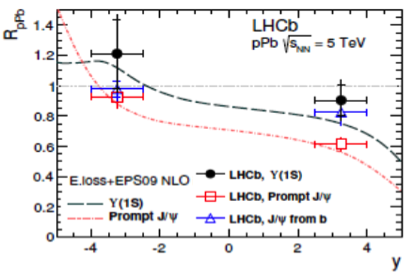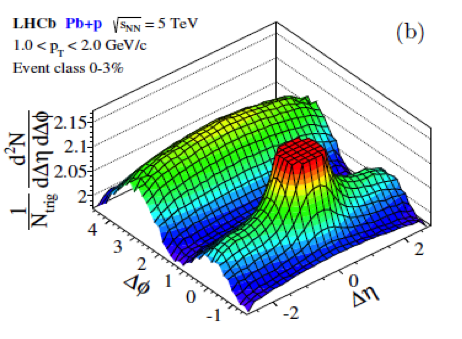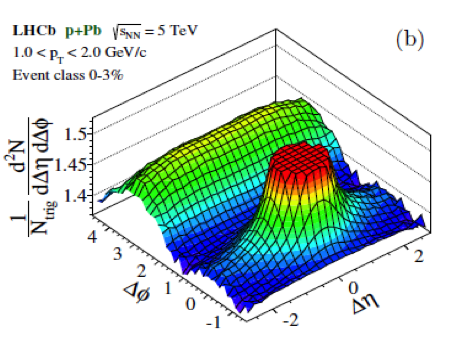LHCb results from proton-lead collisions and prospects for heavy ion interactions
At the 7th edition of the Hard-Probes conference, taking place at McGill University, Montreal, from June 29 - July 3, the LHCb collaboration presented for the first time its plan and potential in heavy ion physics. Beyond the rich programme in flavour physics based on proton-proton collisions, LHCb has participated so far only in the proton-lead run of 2013, but not in the lead-lead runs of 2010 and 2011. The reason has been/was that the detector occupancy in the forward region for central lead-lead collisions is too large. However, detector occupancy is not a problem for proton-lead collisions, neither for more peripheral lead-lead collisions. Since LHCb is fully instrumented in the forward region, it can study nucleon-nucleon collisions in a unique kinematic range.
In the proton-lead run of 2013 LHCb could measure prompt and non-prompt J/y production in the forward region in proton-lead collisions and investigate cold-nuclear matter effects. The excellent vertex resolution of the LHCb detector allowed to distinguish prompt J/y events from J/y events of a B-meson decay. The very good mass-resolution of LHCb allowed also to study Y-production in the forward region and the sequential suppression of the Y(2s) and Y(3s) states. To give access to different rapidity ranges in the proton-nucleon centre-of-mass system, the direction of the proton and lead beams were interchanged during the proton-lead run. The results obtained for the nuclear modification factor of quarkonium production as function of rapidity are summarized in Figure 1, which shows that the suppression in the forward region is smaller for Y(1s) than for J/ψ. On the other hand, a possible enhancement in the backward region can be observed for Y(1s) which might be due to anti-shadowing effects. The overall agreement with predictions of models assuming energy loss and other nuclear effects (EPS09 NLO) is good.

Another interesting result obtained from the proton-lead run of 2013 is in relation to two-particle angular correlations. The correlations were measured as a function of relative pseudorapidity, Δη, and relative azimuthal angle, Δφ, for events in different classes of event activity and for different bins of particle transverse momentum, pT. In high-activity events a long-range correlation on the near side is observed in the pseudorapidity range 2.0 < η < 4.9. This has been the first measurement of the so-called ‘near side ridge’ in proton-lead collisions in the forward region and extends previous observations in the central region. The correlation increases with growing event activity and is found to be more pronounced in the direction of the lead beam.


Figure 2 shows the two-particle correlation functions for events recorded in the proton-lead configuration (left) and lead-proton configuration (right) for the high event-activity classes and prompt charged particles in the pT-range of 1- 2 GeV/c. (The near-side peak around Δη = Δφ = 0 is truncated.)
A key feature of the planned heavy-ion program of LHCb is due to the fact that data can be taken in both colliding-beam and fixed-target mode. In fixed target mode a noble gas such as Neon or Argon is injected in the interaction region. The system used for the injection, called SMOG (System for Measuring the Overlap with Gas), was originally designed for precise luminosity measurements in dedicated runs. However, it allows one to study collisions of protons or lead-ions with the nuclei of the noble gas over longer periods of time at centre-of mass energies of 115 GeV (p-Ar) and 72 GeV (Pb-Ar), and in the rapidity range of about -3 < y < 1 in the nucleon-nucleon centre-of-mass frame. In colliding beam mode data will be taken in the forward rapidity range between 2 < y < 5 at centre-of mass energies of about 5 - 5.5 TeV (for Pb-Pb collisions) and about 8 TeV (for p-Pb collisions). The comparison of the two colliding beam configurations allows to disentangle Quark-Gluon-Plasma (QGP) from Cold-Nuclear-Matter (CNM) effects. The various beam configurations are summarized in the following sketch.

The above values show that a sizeable fraction of the phase space is covered by the LHCb detector, which compared to other experiments has the advantage of precise tracking and vertexing, calorimetry and powerful particle identification over the full detector acceptance. In fixed target mode energy densities are generated between those achieved at the SPS and those probed at RHIC. Doing measurements in colliding beam mode allows one to bridge the gap between the SPS and the LHC in a single experiment.
The focus of the LHCb measurements will focus on one hand on hard probes such as open heavy flavour states and quarkonia, which can be carried out down to low pT. On the other hand, it remains an open question whether the soft sector of QCD can be addressed, which cannot be treated perturbatively.
All in all, LHCb is looking forward to exciting measurements in a variety of beam configurations in the years ahead.
